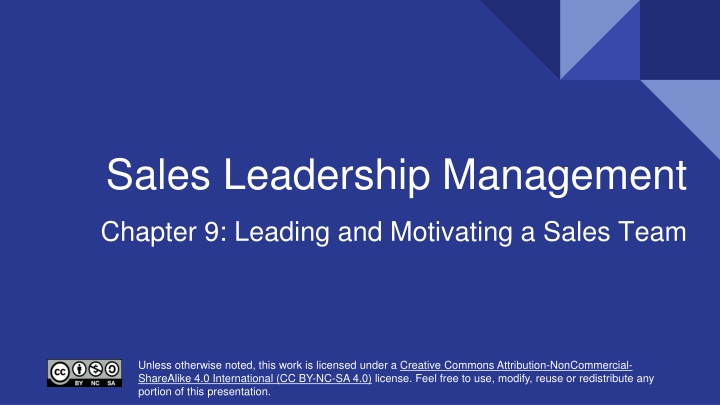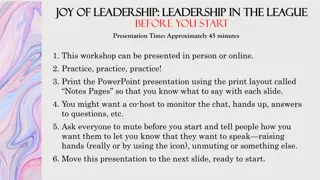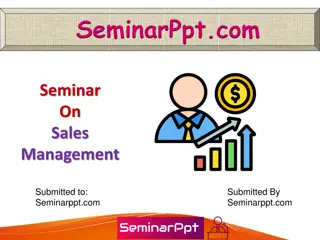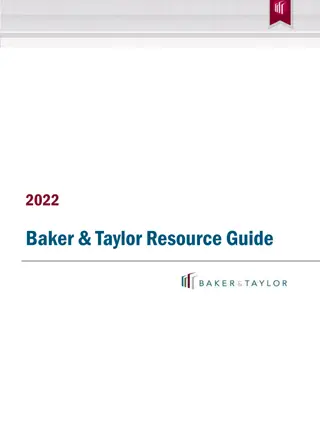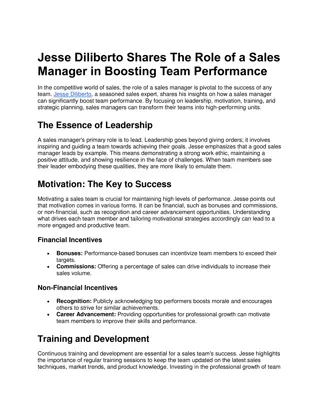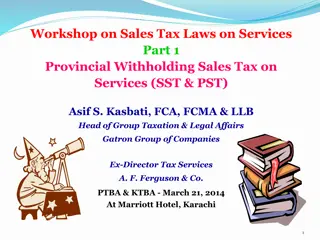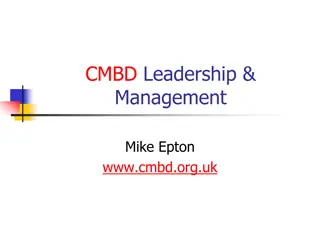Sales Leadership Management
Explore the realms of leadership and management within a sales team, delving into the nuances of different leadership styles and the importance of motivation. Discover how to develop your leadership skills, manage a global sales team effectively, set goals, and motivate employees through incentive systems, especially during challenging times. Uncover tips to find your own unique leadership style and ways to inspire coworkers ethically.
Download Presentation

Please find below an Image/Link to download the presentation.
The content on the website is provided AS IS for your information and personal use only. It may not be sold, licensed, or shared on other websites without obtaining consent from the author.If you encounter any issues during the download, it is possible that the publisher has removed the file from their server.
You are allowed to download the files provided on this website for personal or commercial use, subject to the condition that they are used lawfully. All files are the property of their respective owners.
The content on the website is provided AS IS for your information and personal use only. It may not be sold, licensed, or shared on other websites without obtaining consent from the author.
E N D
Presentation Transcript
Sales Leadership Management Chapter 9: Leading and Motivating a Sales Team Unless otherwise noted, this work is licensed under a Creative Commons Attribution-NonCommercial- ShareAlike 4.0 International (CC BY-NC-SA 4.0) license. Feel free to use, modify, reuse or redistribute any portion of this presentation.
9.0 Learning Outcomes In this chapter, we will: Compare and contrast leadership and management. Specify the contexts in which various leadership styles are effective. Discuss how to develop your own leadership skills. Outline strategies for managing a global sales team using a hybrid model. Distinguish between goals and objectives. Define motivation, and understand why it is important in the workplace. Discuss conditions required to make goals effective. Explain how incentive systems can be used to motivate employees. Examine strategies to motivate a sales team during a downturn.
9.1 The Nature of Leadership Leadership is frequently defined as the act of influencing others to work toward a goal. Leaders exist at all levels of an organization. Formal leaders have authority and use both positional and personal power to influence others. Informal leaders are without a formal authority within the organization but influence through personal power. Effective leadership helps individuals and groups achieve their goals by focusing on the group s maintenance needs and task needs. Leaders do not rely on force but inspire others to adopt their goals willingly. Leaders are people who take charge of or guide the activities of others. Leaders provide the group with what is required to fulfill its maintenance and task-related needs. Leadership and management are not interchangeable but often go hand in hand. Effective leadership requires management skills like goal-setting, planning, decision-making, and organizing. Effective leadership calls for the ability to manage, and effective management requires leadership.
9.2 Leadership Styles Leadership styles can be categorized into autocratic, democratic, and laissez-faire leaders. Effective leaders adapt their style to fit the relational and situational context. Three modern leadership styles: leader-as-technician: Valued for specialized skills and problem-solving abilities. leader-as-conductor: Brings people together for a common goal and sets the vision. leader-as-coach: Combines talents and skills, serving as a teacher, motivator, and keeper of the goals of the group. Five coaching traits that produce results: Orientation and education. Nurturing and encouragement. Assessment and correction. Listening and counseling. Establishing group emphasis.
9.3 Finding Your Own Leadership Style 5 Tips to Find Your Unique Voice: Know your own values. Determine key leadership traits. Determine leaderships skills you need. Understand your Communication style. Understand your priorities. How good leaders inspire their coworkers: Remember the importance of ethical leadership. Communicating clearly with your team and customers. building relationships. adopting a problem-solving approach. Photo by fauxels, Pexels License
9.4 Managing A Global Sales Team Using A Hybrid Model Hybrid working is a preferred option after the pandemic, modern day managers and leaders should be able to effectively manage and co-ordinate the teams which may be spread geographically through technology. Businesses keen to build strong, committed teams need to think about their people not as resources , but as individuals they have to get to know, value and appreciate. Encourage a healthy work-life balance for happier and more engaged employees. Trust is crucial in hybrid working(trust cuts both ways); establish clear KPIs and find new ways to stay connected. Regular, quality interactions are invigorating for teams: they fire creativity, strengthen bonds, and inspire people to learn from one another; Bring teams together when possible, hold curated meetings, workshops, and sales conferences. Lead by example is an essential skill for leaders in driving a cultural shift and achieving success in a hybrid working environment.
9.5 The Nature of Goals and Objectives Goals and objectives are a critical component of leadership. Goals and objectives provide the foundation for measurement; goals define what an organization aims to accomplish, while objectives are precise, time-based, measurable actions supporting goals. Measures are the actual metrics used to gauge performance on objectives; Measurement is a fundamental requirement and an integral part of strategic planning. Goals and objectives should be tied to the organization's strategy, vision, and mission. Goals and objectives serve to: Gauge and report performance Improve performance Align effort Manage accountabilities
9.5 The Nature of Goals and Objectives Planning starts with a vision and mission, followed by the development of a strategy to realize them. Success is measured by achieving underlying goals and objectives. Goals are set for the entire organization and create a hierarchy of specific objectives. The way that the firm is organized can affect goals and objectives in a number of ways. Top managers set goals for the organization, and lower-level managers set objectives for their respective areas. Goals and objectives provide a form of control and align interests and accountability. Goals and Objectives in Planning
9.6 Motivation Motivation refers to an internally generated drive to achieve a goal or follow a particular course of action. Highly motivated employees focus their efforts on achieving specific goals. It s the manager s job, therefore, to motivate employees. Motivated employees are more productive, have lower absenteeism, and stay in their jobs longer. The recognition of employees achievements may be translated into intrinsic rewards; and through these rewards, the employees may motivate and perform up to their maximum capacity. The reward management system includes intrinsic and extrinsic rewards to appeal, retain, and motivate employees (Salary, bonuses, recognition, praise, flexible working hours, and social rights). Motivating others is a critical skill for anyone managing a team.
9.7 Motivating Employees Through Goal Setting Goal-Setting Theory is one of the most influential and practical theories of motivation; there is strong support that setting goals is related to performance improvements. SMART goals help people achieve results. A SMART goal is a goal that is specific, measurable, aggressive, realistic, and time-bound. Specific and measurable goals lead to higher performance levels. Aggressive goals are also called stretch goals. Goals should be realistic to be motivating; impossible goals can demotivate. Time-bound goals create a sense of urgency and focus. Smart Goals
9.7 Why Do SMART Goals Motivate? SMART goals motivate for a variety of reasons. Sources: Based on information contained in Latham, G. P. (2004). The motivational benefits of goal-setting. Academy of Management Executive, 18, 126 129; Seijts, G. H., & Latham, G. P. (2005). Learning versus performance goals: When should each be used? Academy of Management Executive, 19, 124 131; Shaw, K. N. (2004). Changing the goal-setting process at Microsoft. Academy of Management Executive, 18, 139 142.
9.7 When Are Goals More Effective? Goals are more effective when accompanied by feedback, aligned with employees skills knowledge and abilities, and when employees are committed to them. Downsides of goal setting include hampered performance due to lacking skills, reduced adaptability, focus on measured activities at the expense of other performance aspects, and potential ethical issues. Potential Downsides of Goal Setting Sources: Based on LePine, J. A. (2005). Adaptation of teams in response to unforeseen change: Effects of goal difficulty and team composition in terms of cognitive ability and goal orientation. Journal of Applied Psychology, 90, 1153 1167; Locke, E. A. (2004). Linking goals to monetary incentives. Academy of Management Executive, 18, 130 133; Pritchard, R. D., Roth, P. L., Jones, S. D., Galgay, P. J., & Watson, M. D. (1988). Designing a goal- setting system to enhance performance: A practical guide. Organizational Dynamics, 17, 69 78; Seijts, G. H., & Latham, G. P. (2005). Learning versus performance goals: When should each be used? Academy of Management Executive, 19, 124 131.
9.7 Ensuring Goal Alignment Through Management by Objectives (MBO) A systematic approach to ensure that individual and organizational goals are aligned is Management by Objectives (MBO). First suggested by Peter Drucker (Greenwood, 1981; Muczyk & Reimann, 1989; Reif & Bassford, 1975), MBO involves the following process: Setting company wide goals derived from corporate strategy. Determining team- and department-level goals. Collaboratively setting individual-level goals that are aligned with corporate strategy. Developing an action plan. Periodically reviewing performance and revising goals. 1. 2. 3. 4. 5.
9.8 Motivating Employees Through Performance Incentives Incentives are reward systems that tie pay to performance. The Most Frequently Used Incentives: Piece Rate Systems Individual Bonuses Sales Merit Pay Awards Commissions Team Bonuses Gainsharing Profit Sharing Stock Options
9.9 Motivating the Sales Team During A Slowdown During economic slowdowns, sales leaders should keep teams engaged and motivated by broadening their focus beyond topline numbers. Customizing efforts to draw individual motivation helps maintain a positive and results-driven attitude during pessimism time. Slow sales and recession are different, and it's important to view slow sales as an opportunity for self- assessment and strategic questions. Align the sales organization with a "recession sales win strategy" to maintain a winning approach and attitude. A true focus on value for buyers correlates highly with seller motivation and is crucial for vibrant sales organizations. In difficult times, sales leaders must objectively evaluate their sales pipeline and organize internal teams to capture the market effectively, viewing the situation as a strategic opportunity for long-term gains. During challenging times, continuous skills and capacity building are crucial for sales organizations to thrive and separate themselves from less capable competitors. Sales training should be viewed as an ongoing process to improve skills, knowledge, and results for the entire sales organization.
